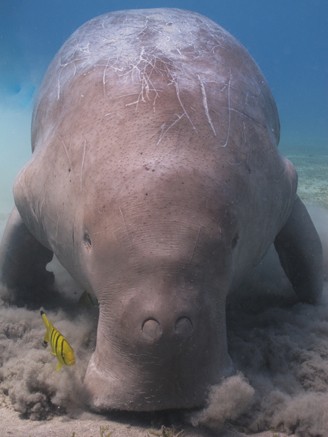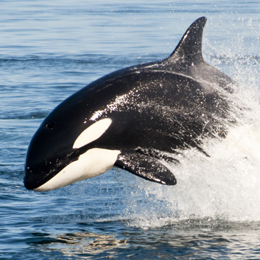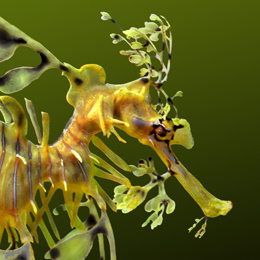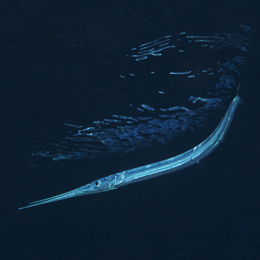Description
The term dugong comes from the word "duyung" in the Malay language. It means a mermaid or the lady of the sea. They are also known as Sea Cows, Sea Pigs, and Sea Camels.
Dugongs are huge marine mammals that are found in warm coastal waters. They are affectionately referred to as sea cows because of their eating habits. They feed exclusively on sea grasses and are completely herbivorous like cows.
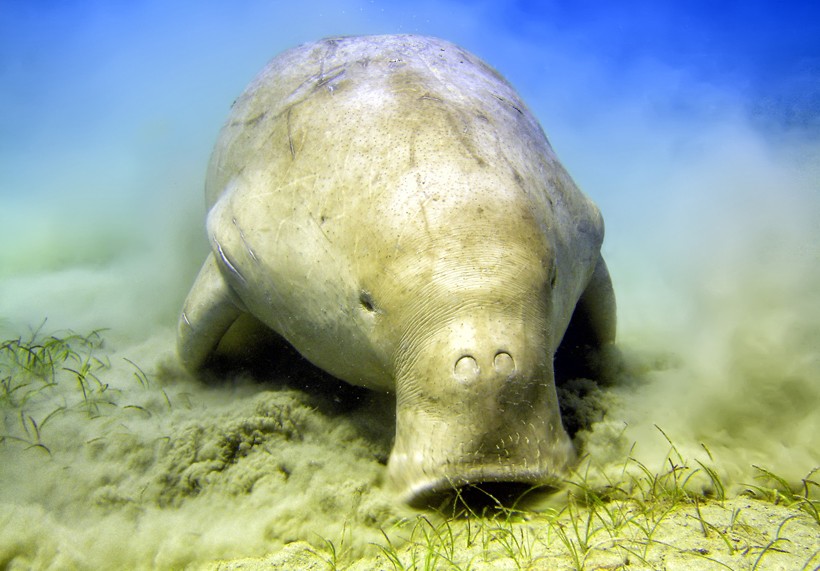
They feed exclusively on sea grasses, and are completely herbivorous like cows.
?
Image credits: Andrea Izzotti
These special creatures look very similar to manatees, as reflected by the fact that both species are related to elephants. There is only one single visual difference in the appearance of both sexes: the dugong males develop tusks on maturity, whereas females do not have visible tusks.
Dugongs are the only surviving species of the Dugongidae family, and one of the four species of the Sirenia order. This makes dugongs truly special and rare. The enormous mammals can grow up to 3 meters in length, and can weight up to 300 kg, resembling overweight dolphins.
Their noses are specially designed with nostrils on top of the snouts. The nostrils open when dugongs return to the water surface to breathe. Dugongs cannot hold their breath for longer times and close its nostrils when they diving again. They have strong hearing, olfactory, and tactile senses but the same cannot be said about their vision capacity.
Anatomy and Characteristics
Dugongs are huge, curious-looking marine mammals. They can grow up to 3 m long, and can weigh up to about 300 kg. They are born with a cream colored skin that turns dark grey or brownish-gray as they reach adulthood. Their thick skin is smooth and covered with sparse hair.
Dugongs have a round head with a large snout and small eyes. A well-developed upper lip forms a U-shaped pad that has double ridges with big, hard bristles. Dugongs have front flippers that look alike paddles
with sizes of about 45 cm. Their fluked tails resemble that of dolphins. The tail, when moved up and down, propels them in water. All dugongs have tusks that break the skin. However, they are visible only in adult male dugongs.
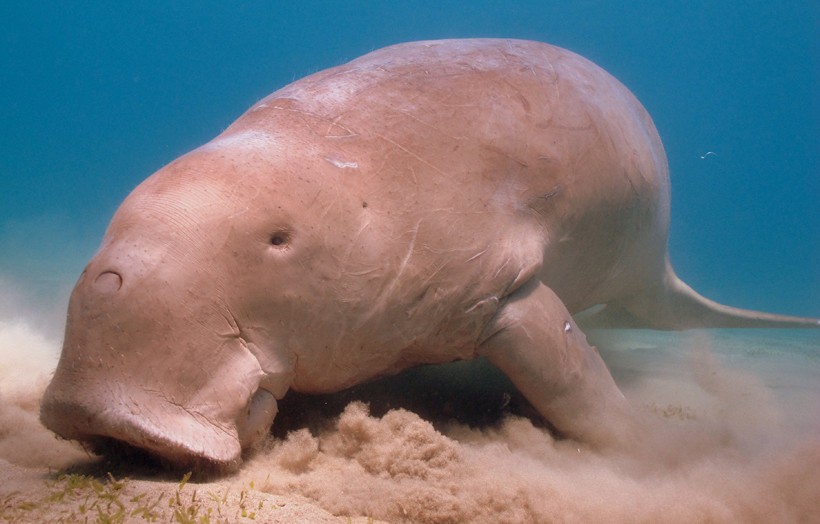
Dugong grazing at shallow lagoon, Marsa Alam (Red Sea, Egypt)
?
Image credits: Kristina Vackova/Shutterstock
Female dugongs have pectoral mammary glands that they use to nurse their offspring. These glands resemble human breasts. The glands may have caused the ancient sailors to imagine dugongs as mermaids.
Dugongs have nostrils on their snouts. These nostrils have special valves that are closed under the water surface and open when they return to the water surface to breath. Dugongs may remain under water for around 6 minutes. The heavy skeleton helps dugongs to dive easily and stay there to eat sea grasses. This diet of sea grass is extremely difficult to digest, and this is the reason why dugongs have very large intestines that can be as long as 30 meters.
Dugong vs Manatee
Dugongs and manatees belong to the same Sirenia order. The Sirenia order contains four living mammals: three manatees and one dugong species. Dugongs and manatees are both related to elephants, and are slow-moving herbivores. But their similarities end there.
Manatees live in marshy lands of the Gulf of Mexico and the Caribbean. Dugongs are found in the shallow protected areas. Dugongs are strictly marine mammals, unlike manatees that can be found in fresh waters.
In spite of the similar appearance, dugongs and manatees have many physical differences. Manatees are a little bigger than dugongs. Also, manatees have paddle-shaped tails that are long and horizontal. The tails have one lobe that moves up and down when manatees swim. Dugongs have dolphin-like tail flukes that have sharp projections. Whereas Manatees have nails, dugongs don't. Also, the nostrils of dugongs are placed on their head unlike the nostrils of manatees.
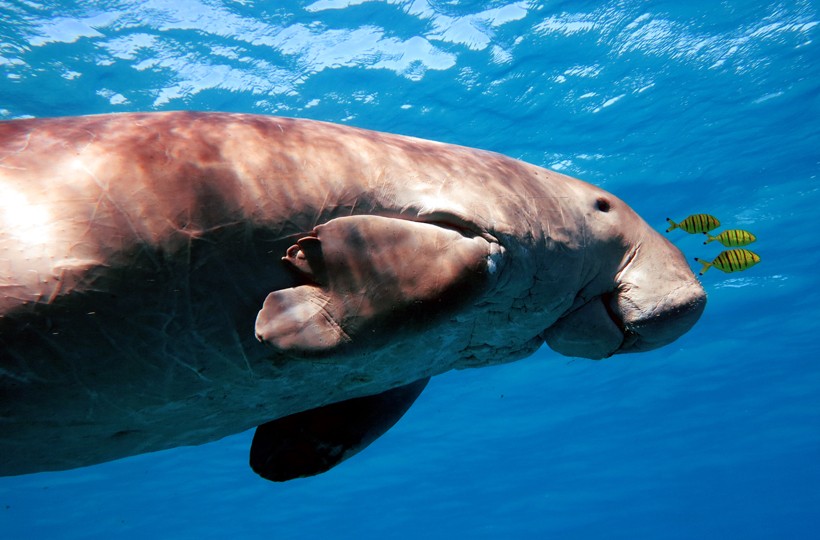
Dugongs have trunk-like snouts, while manatees have shorter snouts.
?
Image credits: RomanMr/Shutterstock
Dugongs have a more pronounced mouth and a trunk-like snout, whereas manatees have a shorter snout. Dugongs have also an undivided upper lip, whereas the upper lip of Manatees is divided.
Whereas male dugongs have incisors that resemble tusks, manatees don't have incisors but only molars.
The differences are not only physically, but can also be found in the reproduction cycle. Female manatees become sexually mature around 3 years of age and give birth every 2 to 3 years. Female dugongs, on the other hand, are sexually mature around 10 years of age and give birth every 3 to 5 years.
Habitat & Distribution
Dugongs are strictly marine mammals. They are found in warm waters at the eastern coast of Africa and the western Pacific Ocean. They are typically concentrated around the shallow protected bays, wide mangrove channels, and towards the leeward regions of island shores. Dugongs are dependent on seagrasses as food source. Therefore, their habitat range corresponds primarily with that of the seagrasses of the families: Hydrocharitaceae and Potamogetonaceae.
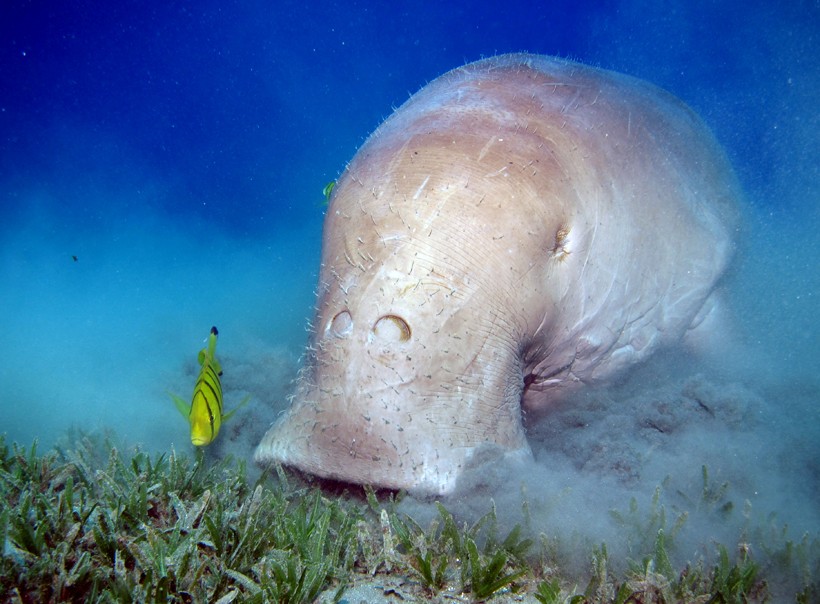
Dugongs are found at warm, shallow protected bays
?
Image credits: LauraD/Shutterstock
Dugongs inhabit waters of around 10 m depth although they are known to travel over 10 km from the shore, and dive in waters as deep as 37 m. Dugongs descend deep in the water to feed on deepwater seagrasses. Shallow waters are preferred to lower the risk of predation, and for reproduction. However, in winter, Dugongs find thermal refuge in deep waters as the water close to shore turns extremely cold.
It is believed that dugongs currently inhabitants 37 countries
- The home to the largest dugong population is Australia.
- In Continental China, Vietnam and Cambodia, the dugongs occur in very small populations.
- The Red Sea contains a population with an estimated number of 4000 dugongs.
- The current population in the Persian Gulf is estimated on 7500 individuals.
- Mozambique and the East African coast have a relatively small population of 120 and 500 dugongs respectively.
- In the Northern Indian Ocean, dugongs are found at the coasts of the Andaman and Nicobar islands, Palk Strait (between India and Sri Lanka) and at the north-eastern coastal belt of Sri Lanka.
- An isolated dugong population exists in the Marine National Park (Gulf of Kutch, India).
- A small population can be found at the coastal areas of Japan, Taiwan and the Philippines. Some dugongs have been spotted also in the western area of the Gulf of Thailand.
-Very small numbers occur in the straits of Johor.
Once Dugongs could also be found around the Maldives and Laccadive islands, but they have become extinct in these areas. Same can be said about the Mediterranean regions, where dugongs once flourished.
-Very small numbers occur in the straits of Johor.
Diet & Predators
Dugongs are huge vegetarians that survive mainly on seagrasses. Their low metabolic rate and extremely slow movement allow them to survive on this completely herbivorous diet. Considering their peaceful seagrass grazing habit, they are fondly called sea-cows.
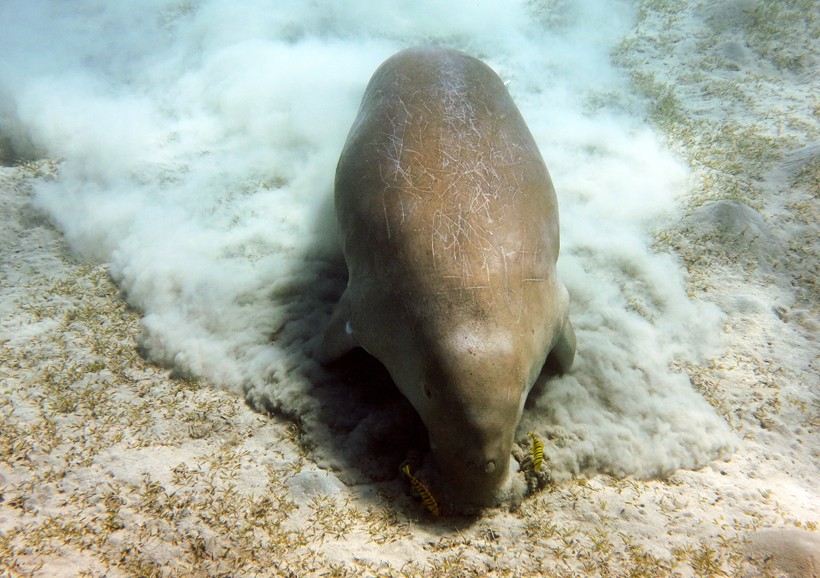
Dugongs prefer seagrasses that are easy digestible, contain relatively few fibers and has high nitrogen levels.
?
Image credits: RomanMr/Shutterstock
Evidence show that dugongs eat a wide variety of seagrasses and also algae. Although dugongs are primarily herbivores, they may eat sea squirts, jellyfish, and shellfish now and then. Studies suggest that dugongs in Australia are omnivores and feed on species of class polychaete (marine annelid worms/bristle worms).
Dugongs prefer seagrasses that are easily digestible, which means a relatively low fiber content and high nitrogen level. This diet is rich in nutrients and, therefore, a bulk intake of seagrass is not necessary.
Dugongs search for food during day and night. They may even go to deep waters for foraging. When searching for food along the seabeds, displacement occurs by movement of their pectoral fins. They have limited vision capacity and, therefore, rely on their strong sense of smell to identify edible plants. Also, their advanced tactile sense helps them feel their surroundings. Dugongs pluck the entire plant, shake it to remove the sand, and eat the complete plant along with the roots. They collect and pile up the plants first at one place before starting their banquet.
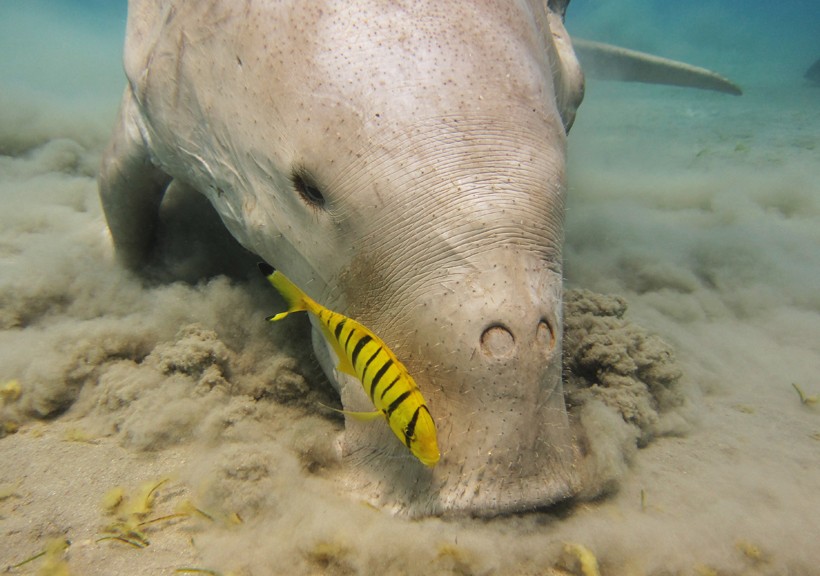
When dugongs are searching for food, they move on their pectoral fins.
?
Image credits: LauraD/Shutterstock
Dugongs are slow-moving animals, so they are vulnerable to predators. The main defenses on which dugongs rely on are their huge size, big bone structure, thick skin, and quick-clotting of blood. They have a few natural predators such as killer whales, sharks and crocodiles. However, these predators predominantly harm juvenile dugongs. Sadly, the most dangerous predators for the dugongs are humans.
Reproduction and Life Cycle
The sexual maturity of dugongs enters around 6 to 17 years of age. Female dugongs attain sexual maturity around 6 years of age, and typically give birth to the first calf between 6 and 17 years. Whereas male dugongs become sexually mature around 6 to 12 years of age. The sexual maturity of dugongs is rather late compared to other mammals. The main trait of identification of sexual maturity in males is the development of tusks. The tusks are developed as a consequence of high levels of testosterone. Evidence proves that there is a decline in fertility among males at advanced ages.
The reproductive rate among these big mammals is low as they reproduce only once in every 2 to 7 years. One reason may be the long gestation period of 13 to 15 months. Males are always waiting for sexually mature female dugongs as the breeding continues around the year.
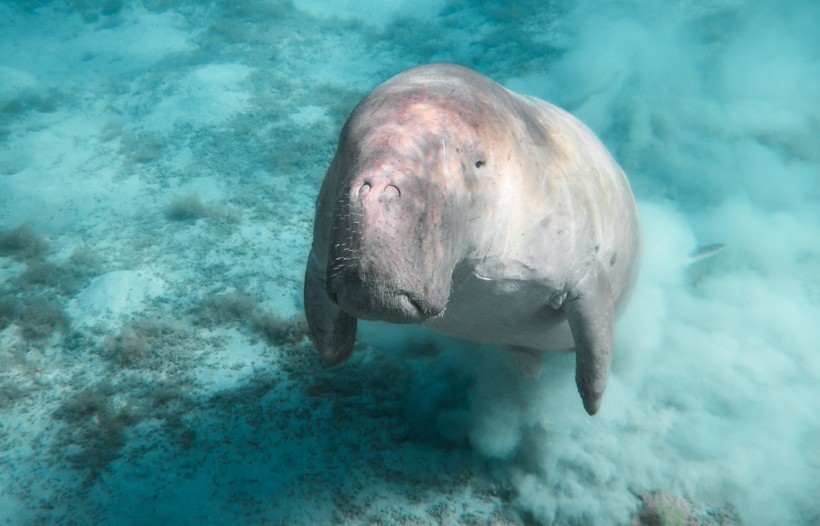
The reproductive rate among these big mammals them is low, and they reproduce only once in every 2 to 7 years
?
Image credits: mrHanson/Shutterstock
Mating behavior among dugongs may slightly differ with habitats. For example, in Australia, the mating involves aggressive competition among males to win sexually mature female dugongs for themselves. Males will establish a territory which the mature female will visit. The competing males tend to get very violent, protecting their territory, and fight with each male intruder using their protruding tusks.
During the competition, female dugongs are mounted several times by multiple males. This guarantees conception and make them polyandrous.
Calves are born after a long gestation period. The calves measure about 1.2 m in length and weigh around 30 kg. The juveniles are vulnerable to predators. They move with their mothers, and ride on their mothers' back, hardly leaving them. They nurse the calves for almost 18 months. Female dugongs are the primary caregivers, and responsible for the raising of the calves. A strong bond between mother and calf is developed during the weaning period. The female dugongs are known to spend almost 6 years with their offspring. During the first 2 years, mother teaches the young one to feed on seagrasses. The next 5 years are spent feeding together and intensify their bond. Calves leave their mothers when they reach maturity.
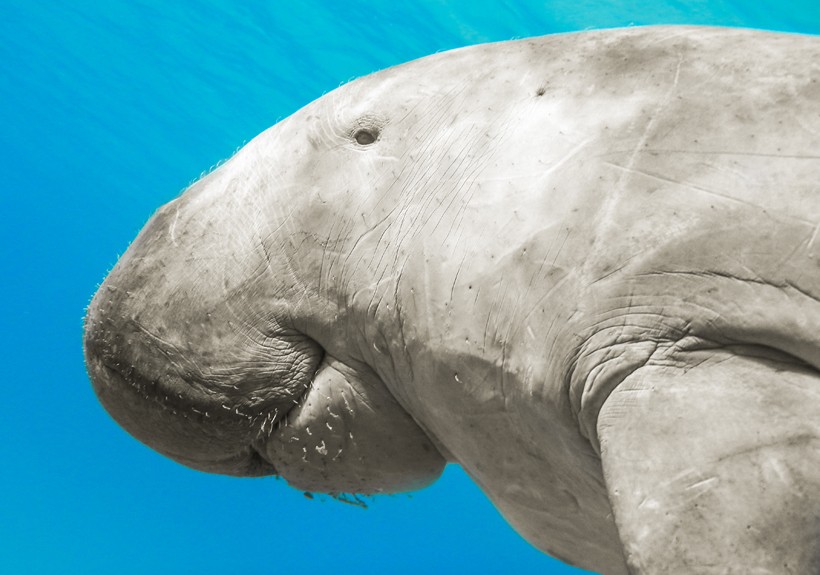
Dugongs live long lives, reaching 70 years or more.
?
Image credits: mrHanson/Shutterstock
Dugongs may become old, reaching 70 years or more. Their age can be determined by counting the growth layers in the tusks. They are highly prone to infectious diseases and parasites. Keeping them in captivity is not cost-effective because of their specialized diet that is difficult (and expensive) to obtain. It is also extremely difficult to keep calves in captivity as they wean for almost 18 months.
Behavior and Communication
Dugongs are known to be social species. They live in groups that range from 2 to 200 individuals. Smaller groups of 2 individuals consist of mother and her offspring. Large groups of 200 individuals are seen rarely as such groups require huge amounts of seagrasses to support them all.
Dugongs are semi-nomadic species, and migrate over long distances to find suitable seagrass beds. If not necessary, they may also inhabit a single area for life. Traveling to "greener pastures" depends on the quality and quantity of seagrass available. They are forced to move to other locations if the seagrass in their habitat is depleted.
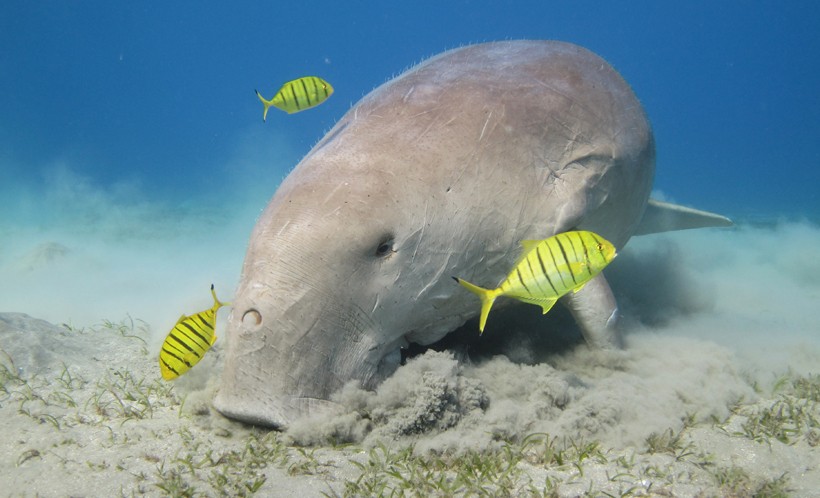
The digging of the dugong results in a feast for pilot jacks
?
Image credits: LauraD/Shutterstock
These gigantic mammals are extremely shy and move away from any source of disturbance. Therefore, it is difficult to observe them in turbid waters. Since Dugongs avoid human beings, it is a difficult task to study their behavior.
As they are social animals, communication is vital for them. Sound and vision are the two primary ways of communication. Dugongs use whistles, chirps, barks, and squeak sounds to communicate. Each sound is for a specific purpose. For example, they chirp when they are searching for food and when patrolling territories while barks reflect their aggressive behavior. They have a highly developed hearing system as they have to identify different sound frequencies. This hearing system is used for communication over longer distances as visual communication is used only close ranges.
Dugongs use their sense of smell and bristles to find food. They have sensory bristles all over their bodies for enhancing their tactical senses. These bristles can detect vibrations from surrounding areas, helping them in the search for food. Also, mother and her calf are maintaining physical contact by means of these bristles.
Conservation Status
Over the years the dugong population has considerably declined, making them a species that is vulnerable for extinction. The young dugongs are being preyed by predators such as sharks and killer whales. But their biggest threat comes from humans.
Dugongs are widespread hunted for their meat and oil. They are trapped in the nets meant for fish and sharks, resulting often in death due to insufficient oxygen supply. They are also regularly struck down by ships and boats. On top of that, their natural habitats are disturbed. The ocean water is getting more and more polluted, resulting in the destruction of seagrass beds which is the primary source of food for dugongs. This directly impacts the survival of dugongs.
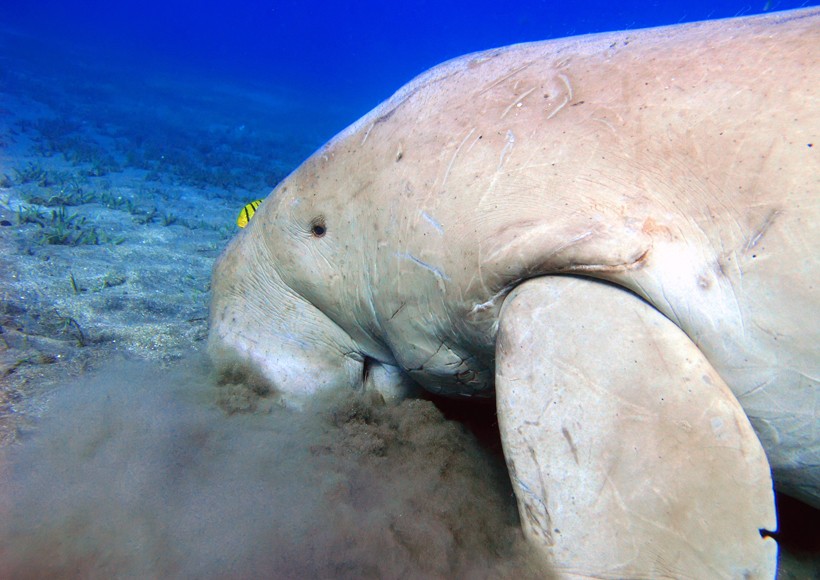
The dugong population has considerably declined, making them a species that is vulnerable to extinction.
?
Image credits: Willyam Bradberry/Shutterstrock
It is difficult for dugongs to rapidly increase the population. As mentioned earlier, they have a very low reproductive rate. Moreover, it is impossible to keep them in a captive environment for safe breeding.
For the survival of dugongs, it is crucial to protect their natural habitats and to reduce human impact on that. In Australia, around 16 protected sites for dugongs have been raised. These sites resemble an ideal environment with abundant seagrass to help dugongs to survive. These areas include also shallow waters for breeding.
Cultural Depictions
Dugongs are of great cultural significance. They form an integral part of the people living along the Great Barrier Reef World Heritage Area. Dugongs as a food source enhance the culture of Aborigines and Torres Strait Islanders. Hunting dugongs, and sharing the meat is a form of continuation of the age-old cultural traditions.
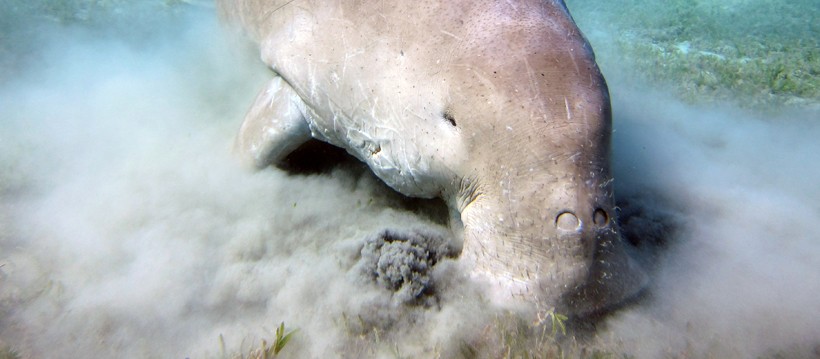
Dugongs have great cultural significance in countries like New Zealand, Japan, Thailand, Papua New Guinea and India
?
Image credits: LauraD/Shutterstock
Dugongs are also a symbol of the ancient culture for the people of Okinawa. For this reason, dugongs are listed under Japan's Law for the Protection of Cultural Properties as an object of cultural significance.
In Thailand, dugongs were believed to have magic properties, and many items were made using different dugong body parts. In India, dugong meat is considered to be an aphrodisiac. In Papua New Guinea, dugongs are a symbol of strength and in Kenya, body parts of dugong are used as medicine, food and decoration items.
Evolution History
Manatees and dugong belong to the order of Sirenia. The fossil records of these marine mammals date back to 50 million years ago. Tethytheria is considered as a connecting part of the evolution of elephants and belongs to Paenungulata which is also including Sirenia.
Tethytheria were initially land animals and later became aquatic and semi-aquatic animals. The reason why they returned to water is likely food related. Recent molecular evidence shows that there is a close evolutionarily relation between tethytheria, elephants and dugongs.
Funfacts
- Dugongs and manatees are the only surviving marine mammals of the Sirenia order.
- Sometimes, dugongs stand on their tails, and take their heads out of the water.
- Dugongs are believed to have inspired the ancient tales of mermaids and sirens.
- As soon as a dugong is born, the mother pushes the infant out of the water onto the surface to start breathing.
